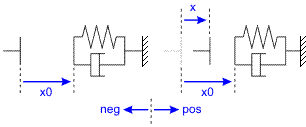Iconic Diagrams\Mechanical\Translation\Components
Right
Left
Domains: Continuous. Size: 1-D. Kind: Iconic Diagrams (Translation).
This model represents an collision of an object with the ground.

The collision force is modeled by a spring and damper:
p.F = if x > x0 then k*(x-x0) + d*limit(p.v,0,1e20) else 0 end;
with a stiffness k and damping d. The limit function is used to prevent the damper force to become negative. The initial position of the spring is indicated by x0 (see the figure above). Note that the positive direction is to the right. If x is larger that x0, the two sides have collided and are in contact. The collision model has separate high and low ports. The equations are
p.F = p_high.F = p_low.F
p.v = p_high.v - p_low.v
Ports |
Description |
p_high p_low |
Two ports of the collision model. |
Causality |
|
fixed force out |
|
Variables |
|
x |
extension of the spring [m] |
Parameters |
|
x0 k d |
unstretched spring position stiffness [N/m] damping [N.s/m] |
Initial Values |
|
x_initial |
The initial extension of the spring [m]. |
This model represents an collision of an object with the ground.

The collision force is modeled by a spring and damper. Note that the positive direction is to the right, so the initial position of the spring x0 has a negative value in the figure above. If x is smaller that x0, the two sides have collided and are in contact.
Ports |
Description |
p_high p_low |
Two ports of the collision model. |
Causality |
|
fixed force out |
|
Variables |
|
x |
extension of the spring [m] |
Parameters |
|
x0 k d |
unstretched spring position stiffness [N/m] damping [N.s/m] |
Initial Values |
|
x_initial |
The initial extension of the spring [m]. |



